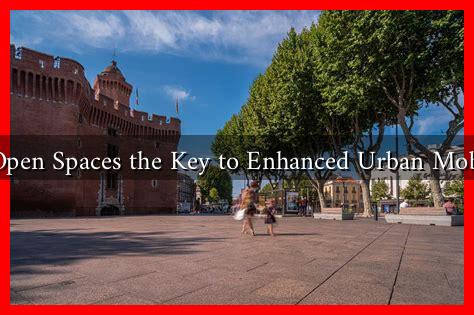-
Table of Contents
Are Open Spaces the Key to Enhanced Urban Mobility?
Urban mobility is a pressing issue in cities around the world, as populations continue to grow and the demand for efficient transportation systems increases. One innovative solution that has gained traction in recent years is the integration of open spaces into urban planning. This article explores how open spaces can enhance urban mobility, supported by case studies, statistics, and expert opinions.
The Role of Open Spaces in Urban Mobility
Open spaces, such as parks, plazas, and greenways, play a crucial role in urban environments. They not only provide recreational areas for residents but also serve as vital components of a city’s transportation network. Here are some ways open spaces contribute to enhanced urban mobility:
- Encouraging Active Transportation: Open spaces promote walking, cycling, and other forms of active transportation. By providing safe and accessible pathways, cities can encourage residents to choose these healthier options over cars.
- Reducing Traffic Congestion: Well-designed open spaces can help alleviate traffic congestion by offering alternative routes for pedestrians and cyclists, thereby reducing the number of vehicles on the road.
- Improving Air Quality: Green spaces contribute to better air quality, which is essential for public health. Cleaner air can lead to increased outdoor activity, further promoting active transportation.
- Enhancing Connectivity: Open spaces can serve as connectors between different neighborhoods and transit hubs, making it easier for residents to navigate the city without relying solely on cars.
Case Studies: Cities Leading the Way
Several cities around the world have successfully integrated open spaces into their urban mobility strategies. Here are a few notable examples:
1. Copenhagen, Denmark
Copenhagen is often cited as a model for urban mobility. The city has invested heavily in cycling infrastructure, including dedicated bike lanes that run through parks and open spaces. As a result, over 62% of residents commute by bike daily. This commitment to active transportation has not only reduced traffic congestion but also improved the overall quality of life for its citizens.
2. New York City, USA
New York City has transformed several streets into pedestrian plazas, such as Times Square and Bryant Park. These open spaces have become vibrant hubs for social interaction and commerce, while also providing safe areas for pedestrians. According to a study by the NYC Department of Transportation, pedestrian injuries decreased by 40% in areas where streets were redesigned to prioritize open spaces.
3. Melbourne, Australia
Melbourne’s “Green Your Laneway” initiative has revitalized underutilized alleyways by turning them into green spaces. This project not only enhances the aesthetic appeal of the city but also encourages walking and cycling. The city has reported a 20% increase in foot traffic in areas where these green spaces have been implemented.
Statistics Supporting Open Spaces and Mobility
Research supports the notion that open spaces significantly impact urban mobility. Here are some compelling statistics:
- A study by the National Recreation and Park Association found that communities with accessible parks and open spaces see a 25% increase in walking and biking.
- According to the World Health Organization, cities that promote active transportation can reduce traffic-related deaths by up to 30%.
- Research from the University of California, Berkeley, indicates that urban green spaces can increase property values by 10-20%, leading to economic benefits for local businesses.
Challenges and Considerations
While the benefits of open spaces in enhancing urban mobility are clear, there are challenges to consider:
- Space Constraints: In densely populated cities, finding space for new parks and open areas can be difficult.
- Maintenance Costs: Open spaces require ongoing maintenance, which can strain municipal budgets.
- Equity Issues: Access to open spaces is not always equitable, with marginalized communities often lacking sufficient green areas.
Conclusion
Open spaces are indeed a key component in enhancing urban mobility. By promoting active transportation, reducing traffic congestion, and improving air quality, cities can create healthier and more connected communities. The successful examples from cities like Copenhagen, New York, and Melbourne demonstrate that integrating open spaces into urban planning is not only feasible but also beneficial. As urban populations continue to grow, prioritizing open spaces will be essential for creating sustainable and livable cities. For further reading on urban mobility and open spaces, visit Urban Land Institute.


